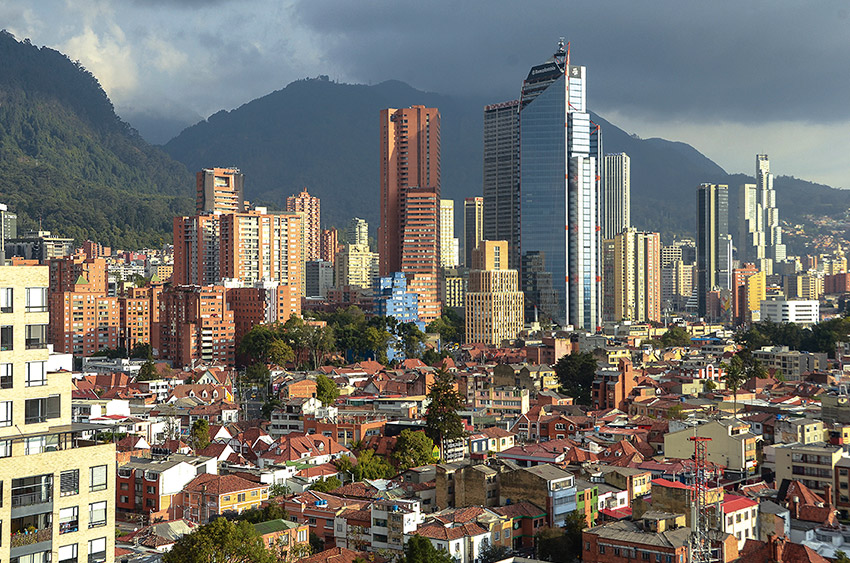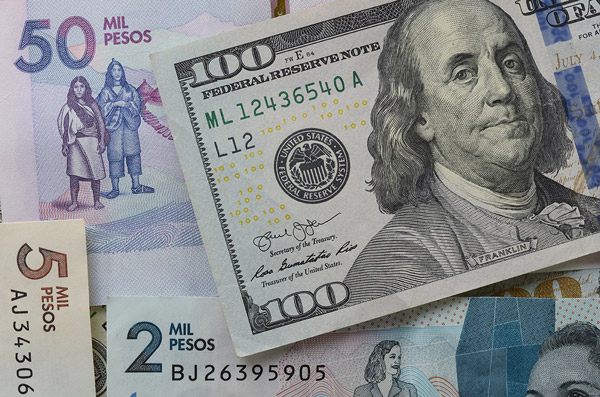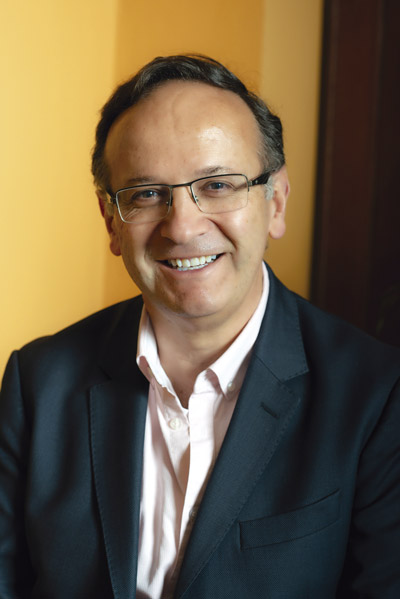The art of looking to the economic future
By: David Mayorga
Photos: Alberto Sierra, Milagro Castro, Archivo DOI https://doi.org/10.12804/dvcn_10336.42361_num7
Economics and Politics

By: David Mayorga
Photos: Alberto Sierra, Milagro Castro, Archivo DOI https://doi.org/10.12804/dvcn_10336.42361_num7
The first few days of each month are busy. The routine repeats itself with the same pattern: mark the fifth business day on the calendar, look for the most relevant data of the moment (the behavior of the exchange rate, the price of food in wholesale power plants, the variations in interest rates)... Everything is important, even the news that describes disorder or alterations, major projects and reforms. The numbers obtained are systematized, graphed, analyzed. Of course, there is also room to answer the big question, the one that begins to be drawn with the sound of a WhatsApp notification: “Hello Caro. How's the dollar going to be?”
“It is a fairly narrow period in which economists have to make decisions, run statistical models very fast,” Carolina Monzón, manager of Economic Research at Bank Itaú Colombia, describes about the start of her monthly routine. She and her team have internalized this ritual because of one particular event: Dane releases its official inflation data on the fifth business day of each month. It is the special ingredient with which the country's statistical research institute defines its forecast on the health of the economy and its main components: the price of the dollar, monetary policy, the behavior of stocks, commodities and those of state financing instruments, among others.
The adrenaline rush increases the next day, when the formal request of the Banco de la República arrives. This is the Monthly Survey of Economic Analysts’ Expectations, better known as EMEs, a crucial instrument by which banks, insurers, broker-dealers, pension and severance funds, among various financial and economic actors, are asked to give their opinion on the direction inflation –and with it the entire economy– will take in the immediate and medium-term future. Or punctually, how they see the course of economic activities for that same month, for 12 and 24 months from now, for next December and Christmas next year.
In a week, that vision for the economic future will be discussed, even more closely, by its leaders in Brazil and Chile, who, in turn, will provide their respective predictions. They will compare figures, review economic policy measures, discuss the next step to follow until they reach a consensus: a final figure to be sent to the Banco de la República and, later, a contextualized explanation to their clients.

The study conducted focused specifically on identifying the variables that professional forecasters use in both their forecasts and revisions. To achieve this, the researchers analyzed the expectations surveys published by the Banco de la República between 2003 and 2019 and compared them with the economic information available during the same period.
Month after month, since September 2003, that routine has been repeated in thirty economic actors with the same style of ‘futurology’. Or, in technical terms, analysis of economic expectations, since its impact is vital among investors, entrepreneurs, managers and even ordinary people with a specific need to acquire a good or hire a service. “For companies, it is essential to have information when making investment decisions: how they are going to finance themselves, whether they are going to keep those financing open, whether they are going to use some type of coverage, look at the deadlines, etc. It is also essential for natural people to plan their investments depending on their risk aversion,” explains Monzón.
The responses obtained by the central bank are a valuable input that allow it to set its intervention policies: increase or decrease the interest rate, buy or sell more dollars to stabilize the exchange rate and, in particular, provide baseline information to motivate investments in the country. In this way, confidence is created among economic actors so that the economy remains dynamic.
“When the Bank adopts some kind of policy, its effects tend to endure over time,” says Jesús Otero, a doctor of economics, professor of Universidad del Rosario and researcher who is an expert in time series, or the analysis of information and variables that allow predicting the direction the economy will take.
In 2020, together with Ana María Iregui, a researcher of Banco de la República, andHéctor Mauricio Núñez, a professor of the Center for Economic Research and Teaching in Mexico (CIDE), Otero carried out research to identify the data and, in particular, the variables that professional forecasters use in their predictions to the Issuer. “We believed that this information was underused and that we could review the efficiency of forecasting,” he says. His work was included in Essays on Economic Policy, the central bank’s 100th specialized publication on inflation policy surveys, and was published in the pages of the Journal of Economic Behavior and Organization under the title “Testing the efficiency of inflation and Exchange rate forecast revisions in a changing economic environment.”
His intention was not only to advance the empirical evidence on this topic, but also to describe in the most precise way the instrument that has helped define the course of Colombian economic policy in the last 20 years.
Between magic and mathematics
The future has always haunted societies. In Ancient Greece, for example, kings were heading to a cave on Mount Parnassus, near the village of Delphi, where an old woman predicted her fate (and that of her nations) in the form of a riddle. This divinatory power was also celebrated by the so-called prophets of Jewish origin, who used it from the interpretation of dreams to the prediction of a messiah who would lead his people to the glory of their god. He was even present in the last days of the Middle Ages with the publication of the prophecies of St Malachy, an Irish archbishop who saw clearly the fate of each of the future popes of the Catholic Church.
However, with the advent of modernity and the establishment of capitalism, this exercise fell into disuse. As the German sociologist Max Weber described it, prophecies went from magical to rational terrain to give rise to a reality explained by science, technology, and especially economics. Thus, in the 19th century, mathematical and statistical methods such as linear regressions and time series models appeared, which, through the analysis of historical data, defined a trend.
That is, the past was consulted to predict the future.
Already in the 20th century, in the years leading up to World War II, expectations surveys were implemented, with which informed economists, experts in data modeling, were consulted on the identification and interpretation of variables with which changes in economic activity could be anticipated.
“According to John F. Muth, one can think of an expectation as an informed forecast,” notes Otero, who describes that these predictive readings are based on an econometric model, an equation or an economic theory that allows predicting with less or more certainty what will happen to a variable such as inflation, the price of coffee and food production, among many more.
When the Banco de la República conducts its survey of expectations among the main economic actors, it usually asks two types of questions: what will happen to variable X in the next 12 months? (known as a fixed horizon or forecast with a set date); similarly, what will happen to variable X in a given period, such as the end of the year, or in a fixed event?
And this is where the predictive skills of each professional forecaster come in, setting for the first scenario a long-term trend, but, in view of the second, you need to adjust your calculations as you approach the event in question. As this exercise is done on a monthby- month basis, the real difference is made by anyone who can correct their original forecast with the most relevant information available.
In fact, what would seem like a real-life contradiction (for one to correct what so much work it took to establish) can become a sign of trust.
“I always keep in mind the teaching that a boss left me, who said to me: ‘It helps me that you change my inflation forecast a day or two before the publication of the official data, because this way I can position my investments much better’, recalls Carolina Monzón.
Indeed, her experience has become a key factor in defining what kind of information can lead her to revise her calculations: “Sometimes we weigh the reasons why forecasts are adjusted. If there is a big data coming up, like the closure of the Bogotá-Villavicencio road, I think we have to incorporate it; but it would not be so much the case of a taxi drivers strike that lasts a day.”
A question of variables
The study carried out by Otero and his colleagues focused precisely on identifying the variables that professional forecasters use both in their forecasts and in their reviews. To do this, they used the expectations surveys published by the Banco de la República between 2003 and 2019, and contrasted them with the economic information available during the same period.
Their analysis, based on statistical models and the use of machine learning (an artificial intelligence technique to process existing information), allowed them to confirm what the economic literature on economic predictions states: that forecasters do not usually review their predictions in periods of macroeconomic stability and cling to the variable itself in their analyzes. For example, the Consumer Price Index (CPI) for inflation, the Representative Market Rate (TRM) for the exchange rate, the interest rates for the variation in the cost of credits, and so on…

“According to John F. Muth, one can think of an expectation as an informed forecast,” notes Jesús Otero, professor in the Faculty of Economics, who describes that these predictive readings are based on an econometric model, an equation or an economic theory that allows predicting with less or more certainty what will happen to a variable such as inflation, the price of coffee and food production, among many more.
The most interesting finding, however, came when the economy suffers from so-called “shocks” – unexpected events, such as natural phenomena, social outbreaks, or external economic contagion that alter the usual course of economic activity.
“To the extent that the economy faces more shocks, forecasters use more variables. We identified more than 30”, says Otero. Examples include the effects of the El Niño or La Niña phenomenon, changes in oil prices or industrial production in other countries. They even considered the potential use of variables obtained with text analysis: “For social demonstrations, Google Trends searched the number of queries for terms such as “strike,” “protest,” or “rally” (see box).
The strict lockdown and the measures adopted during the Covid-19 pandemic also led Carolina Monzón and her team to contemplate new variables that emerged precisely from the analysis of texts: “In those days we were following in Google a local mobility indicator that was published day by day and that allowed us to project how economic activity, production, retail sales and so on was evolving, even unemployment...”.
The return to normalcy and the economic revival left that indicator, built from Google Maps images, in disuse. Today, Monzón’s lead analysts use other inputs, such as climate data, to estimate the impact that changes, for example, in rainfall patterns and global temperatures, can have on food crops and thus on future inflation data.
For his part, this learning has allowed Otero to explore the potential of the variables obtained through text analysis in the formation of forecasts for the price of energy raw materials, as in the case of oil. In short, just as people adapt to unexpected changes in the economy, so do economists who predict the future: “When you as an economist make theoretical models, sometimes you simplify by saying that we are all the same, that we all use the same methods. However, it is not really like that. We do not all use the same variables in our analysis,” Otero says.
Forecasts built with tweets
Virtual searches, social media activities, and any activity we do on the Internet are incredibly valuable data to build forecasts about the future of the economy. This is possible thanks to textual analysis, a technique originated in the social sciences that has allowed to establish political and ideological positions of the authors of written texts, public speeches or media interventions. These textual inputs can also be analyzed with statistical methods used to process highdimensional information, such as machine learning processes (used mainly in artificial intelligence) and computational biology.
Thus, analysts use a text (it can be a news story, a political discourse and even a set of tweets) to which they apply certain restrictions to identify common words, and assigning values to find causal relationships when comparing them. This is such a useful and day-to-day procedure that it allows, among other applications, an email provider to determine which messages are or are not going to the spam tray.
This procedure is also used to construct economic forecasts: in macroeconomics, news searches help to identify variations in inflation or unemployment or doubts about the implementation of an economic policy, while in marketing and business administration advertising and reviews of products on networks can help to predict consumption trends.
When it comes to political economy, the speeches of election candidates identify partisan agendas and their effects on the electorate. And, of course, financial analysts often monitor news media and Internet users’ behavior to predict the future price of a stock market share.